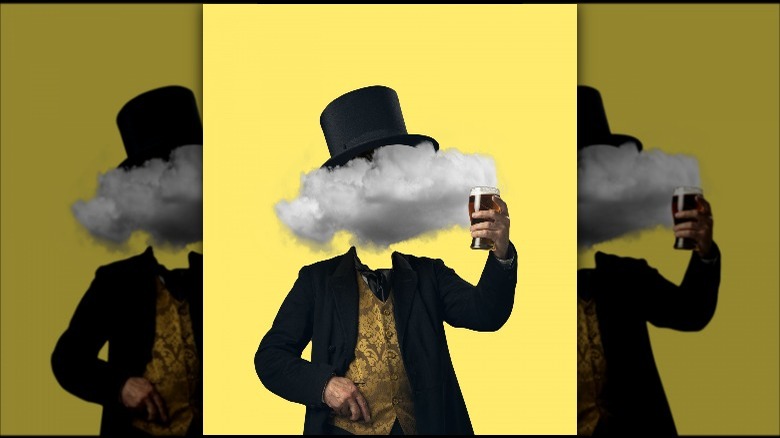The Untold Truth Of 19th-Century Conman George C. Parker
A life working at Raymond Street Jail came rife with the various inconveniences of keeping human beings in cages every day. The ordinary human beings who held the keys to these cages took solidarity with their fellow keepers of the captives. Every complex of cages where human beings were confined derived the essence of its panopticon effect from observation and restrictions on movement. Guards, often sleepy and stone-faced, stood watch at prison doors.
One day in the early 1900s, one such guard at Raymond Street Jail stood at his post with inattention. Observing the intermittent flow of visitors, he noticed the sheriff's jacket among the outerwear of those departing the jail. The guard salaamed at the sheriff's hat and shouted, "Happy New Year!" The hat, bobbing along with the man's footsteps, disappeared through the door of Raymond Street Jail, presumably not to return until his next shift at the building.
According to The Brooklyn Daily Eagle, the man never returned. He was not the sheriff at all. He was George C. Parker, confidence man, convicted for grand larceny and infamous for "selling" the Brooklyn Bridge, the Metropolitan Museum of Art, Grant's Tomb, and the Statue of Liberty. He charmed his targets, forged sales documents, and walked away with cash in hand. Now he had simply walked out of Raymond Street Jail.
'If You Believe That, I Have A Bridge to Sell You'
According to The New York Times, Brooklyn was a hotspot for confidence men in the late 19th century. Newly-docked ships carried dozens of new immigrants ready to taste the fruit of this "land of opportunity." For these immigrants, the shore contained fruit. But some cash-savvy New Yorkers sensed opportunity of a different kind: these immigrants' lack of knowledge about United States law, and their natural human desire to get a taste of opportunity — in particular, a piece of the United States.
New York City contained so many wonders of modernity. An unbelievable landscape of wealth, industry, and multiculturalism, right? There were plays criticizing the United States government, scandalous music played in public, and a thriving free press. There was an abundance of jobs, wealth, food, and commercial goods you'd never believe. It was the land of opportunity, the melting pot of the world.
"And if you believe that, I've got a bridge to sell you." Or the catchphrase was presumably something to that effect, as George C. Parker made his living doing exactly that.
The Pretext & the Pitch
George C. Parker bribed the Ellis Island ferry drivers to scout out potential marks and send them his way. Naked History says the newly-arrived immigrant, with little understanding of American norms or law, would then be presented with the opportunity of a lifetime: to buy the Brooklyn Bridge. Parker would present his target with a stack of forged documents verifying his status as owner of the bridge. According to Parker, the government was passing a new law that would allow investors to become partial owners of the bridge, erect their own toll booths, and then keep a percentage of the income from the tolls.
After listening to Parker's seductive pitch, the mark agreed to sign on as an investor for a mere $5,000 (equivalent to over $150,000 today, per MeasuringWorth). Now a partial owner of the Brooklyn Bridge, Parker's victim would attempt to erect a toll booth at the bridge impasse, only to be stopped by police and discover the "deal of a lifetime" had been a fraud, as The New York Times reported.
The Professional Life of George C. Parker
According to Ephemeral New York and The Brooklyn Daily Eagle, Parker's scheme was wildly successful. According to Parker himself, he sold it twice a week. He claimed the average going rate for the bridge was about $5,000. (The Sikeston Standard reported Parker even offered a more affordable deal: $4,000 for the bridge with only $1,000 down.)
His full-time job as a Brooklyn Bridge salesman was going so well that he decided to expand his portfolio of offerings: the Statue of Liberty, Madison Square Garden, the Metropolitan Museum of Art, and Ulysses S. Grant's tomb were all on the list. According to Naked History, Grant's desperately aggrieved grandson (in actually, George C. Parker) couldn't afford to finish his grandfather's tomb. Investors (who were, in actuality, Parker's marks) were too happy to help by handing over their money.
Why was the Brooklyn Bridge scheme so successful? Parker was certainly not the only confidence trickster to "sell" it (as the New York Daily News noted). Thanks to the Brooklyn Bridge's close proximity to the port, it was among the first sights passengers saw on American shores. It was also one of the iconic symbols of United States culture (as was the Statue of Liberty). Who wouldn't want to own a piece of the United States of America?
Perhaps the victims of Parker's Brooklyn Bridge scheme did, in fact, receive a portion of the American dream: grandeur, illusion, and some man who wants your money.



